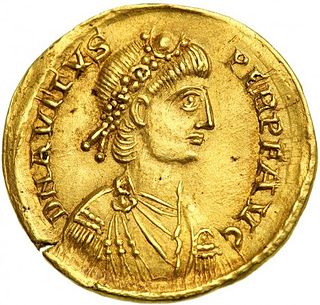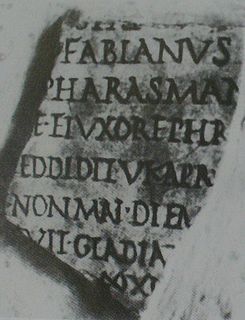
Glycerius was Roman emperor of the West from 473 to 474. He served as comes domesticorum during the reign of Olybrius, until Olybrius died in November 472. After a four-month interregnum, Glycerius was proclaimed Western Emperor in March 473 by the magister militum and power behind the throne Gundobad. Very few of the events of his reign are known other than that during his reign an attempted invasion of Italy by the Visigoths was repelled, diverting them to Gaul. Glycerius also prevented an invasion by the Ostrogoths through gifts.

Anicius Olybrius was Roman emperor from July 472 until his death later that same year; his rule as augustus in the western Roman Empire was not recognised as legitimate by the ruling augustus in the eastern Roman Empire, Leo I. He was in reality a puppet ruler raised to power by Ricimer, the magister militum of Germanic descent, and was mainly interested in religion, while the actual power was held by Ricimer and his nephew Gundobad.

In vertebrate anatomy, the pituitary gland, or hypophysis, is an endocrine gland, about the size of a pea and weighing, on average, 0.5 grams (0.018 oz) in humans. It is a protrusion off the bottom of the hypothalamus at the base of the brain. The hypophysis rests upon the hypophysial fossa of the sphenoid bone in the center of the middle cranial fossa and is surrounded by a small bony cavity covered by a dural fold. The anterior pituitary is a lobe of the gland that regulates several physiological processes including stress, growth, reproduction, and lactation. The intermediate lobe synthesizes and secretes melanocyte-stimulating hormone. The posterior pituitary is a lobe of the gland that is functionally connected to the hypothalamus by the median eminence via a small tube called the pituitary stalk.

Eparchius Avitus was Roman emperor of the West from July 455 to October 456. He was a senator of Gallic extraction and a high-ranking officer both in the civil and military administration, as well as Bishop of Piacenza.

Nicander of Colophon, Greek poet, physician and grammarian, was born at Claros, near Colophon, where his family held the hereditary priesthood of Apollo. He flourished under Attalus III of Pergamum.

The dean of St Paul's is a member of, and chair of the Chapter of St Paul's Cathedral in London in the Church of England. The dean of St Paul's is also ex officio dean of the Order of the British Empire.
Aulus Platorius Nepos was a Roman senator who held a number of appointments in the imperial service, including the governorship of Britain. He was suffect consul succeeding the consul posterior Publius Dasumius Rusticus as the colleague of the emperor Hadrian for March to April 119 AD.

The buccinator is a thin quadrilateral muscle occupying the interval between the maxilla and the mandible at the side of the face. It forms the anterior part of the cheek or the lateral wall of the oral cavity.

The anconeus muscle is a small muscle on the posterior aspect of the elbow joint.

Euphemia, known as the All-praised in the Eastern Orthodox Church, is a Christian saint, who was martyred for her faith in 303 AD. According to Christian tradition, this occurred at Chalcedon.

Libius Severus, sometimes enumerated as Severus III, was emperor of the Western Roman Empire from 461 to his death in 465. A native of Lucania, Severus was the fourth of the so-called Shadow Emperors who followed the deposition of the Valentinianic dynasty in 455. He ruled for just under four years, attaining the throne after his predecessor, Majorian, was overthrown by his magister militum, Ricimer. Severus was the first of a series of emperors who were highly dependent on the general, and it is often presumed that Ricimer held most of the de facto power during Severus' reign
Anonymus Valesianus is the conventional title of a compilation of two fragmentary vulgar Latin chronicles, named for its modern editor, Henricus Valesius, who published the texts for the first time in 1636, together with his first printed edition of the Res Gestae of Ammianus Marcellinus. The two fragments are not related, one being from the fourth century and the other from the sixth. The only connection between the two fragments is their presence in the same manuscript and their history of being edited together. When Henricus' brother Hadrian re-edited the Anonymus in an edition of Ammianus Marcellinus in 1681, it was the first time that the two excerpts were clearly separated.
Remistus was a general of the Western Roman Empire, commander-in-chief of the army under Emperor Avitus.
The Fasti vindobonenses are two sets of late antique consular annals ("fasti"), found in the Vindobonensis manuscript MS. 3416, together with the Chronography of 354. They were previously known as Anonymus Cuspiniani, since they were published by Johannes Cuspinianus in 1553, and are part of the Consularia Italica collection.
Hipparchicus is one of the two treatises on horsemanship by the Athenian historian and soldier Xenophon (circa 430–354 BC). Other common titles for this work include The cavalry commander and The cavalry general. The other work by Xenophon on horsemanship is Περὶ ἱππικῆς, Perì hippikēs, usually translated as On horsemanship, De equis alendis or The Art of Horsemanship. The title De re equestri may refer to either one of the two works. Hipparchicus deals mainly with the duties of the cavalry commander (hipparchus), while On horsemanship deals with the selection, care and training of horses in general.

The Fasti Ostienses are a calendar of Roman magistrates and significant events from 49 BC to AD 175, found at Ostia, the principal seaport of Rome. Together with similar inscriptions, such as the Fasti Capitolini and Fasti Triumphales at Rome, the Fasti Ostienses form part of a chronology known as the Fasti Consulares, or Consular Fasti.
Rufius Postumius Festus was a Roman aristocrat who lived during the Late Roman Empire. Festus was the last consul appointed by an Emperor in the West. The next consul appointed in the West was Caecina Decius Maximus Basilius, whom king Odoacer appointed in 480, eight years after Festus.










